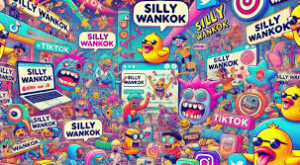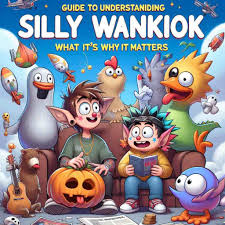Understanding Silly Wankok
The concept of “silly wankok” first emerged within various cultural discussions as a term that represents something absurd or nonsensical, often eliciting humor. The direct translation may vary based on cultural interpretations, but the underlying message remains clear: it embodies a playful spirit that encourages individuals to embrace the lighter aspects of life. This whimsical journey through the term’s origins reveals a rich tapestry of humorous associations and anecdotal references that have surfaced over time.
The Appeal of Silly Wankok
The whimsical nature of silly wankok captivates many individuals by tapping into deep-rooted psychological and emotional responses associated with humor and enjoyment. Fundamentally, humor serves as a conduit for stress relief and escapism, allowing people to step away from their daily routines, engage with frivolous content, and embrace laughter. Silly wankok, in particular, embodies an exaggeration of this lighthearted experience, making it a particularly enticing form of entertainment.
One contributing factor to the appeal of silly wankok is its inherent unpredictability. The intentional nonsensical elements resonate with audiences who appreciate absurdity in their entertainment. For instance, children’s literature and animated shows often employ this playful absurdity, presenting characters and scenarios that encourage laughter through their sheer ridiculousness. Classic works, like those created by Dr. Seuss, showcase how whimsical plots and quirky language can successfully engage children while simultaneously appealing to adults through nostalgia and wittiness.
Moreover, silly wankok exists across various media, from cartoons and television series to jokes shared on social media platforms. Think of how memes often integrate nonsensical phrases or gleeful absurdity to connect with audiences, spreading joy and amusement. This forms a communal experience, as individuals share laughter and exchange reactions to instances of silly wankok in everyday life. Furthermore, participating in such whimsical exchanges can elevate moods, foster social connections, and even enhance creativity, highlighting the multifaceted role that silliness plays.
In essence, the allure of silly wankok lies in its ability to elicit genuine laughter, facilitate social bonds, and provide an enjoyable escape from the mundane. This cherished element of human experience serves not only as a source of entertainment but also as a reflection of our collective desire to embrace joy and whimsy amidst the complexities of modern life.

Silly Wankok in Pop Culture
The phenomenon of silly wankok has permeated various aspects of pop culture, illustrating its resonance with contemporary humor and entertainment. One notable example can be found in animated series, where exaggerated and absurd forms of comedy often lead to the introduction of silly wankok characters. Shows like “Rick and Morty” creatively explore the absurd, frequently featuring outrageous scenarios that evoke the spirit of silly wankok, inviting audiences to embrace the nonsensical elements of life while prompting them to reflect on deeper societal issues.
In film, the concept of silly wankok can be identified in comedies that thrive on absurdity and whimsy. A clear instance is the cult classic “Dumb and Dumber,” in which the characters’ senseless antics create a humor that resonates with fans of the genre. This film exemplifies how silly wankok can be a vehicle for laughter, as characters find themselves embroiled in increasingly ludicrous situations, leading to an appreciation for the ridiculousness of human behavior.
Social media platforms have also played a crucial role in popularizing silly wankok. Viral videos and memes often tap into this whimsical theme, with users sharing content that highlights the absurdity of everyday life. For instance, TikTok has become a breeding ground for short comedic sketches that capture the essence of silly wankok, showcasing users’ interpretations of eccentric characters or situations. This instantaneous sharing fosters a community that enjoys humor based on these quirky elements, ensuring that silly wankok remains relevant in contemporary conversations.
Moreover, television talk shows frequently incorporate the silly wankok theme, through humorous skits or segments. These appearances solidify its place in popular culture, showcasing the universality of this whimsical humor. The impact of silly wankok is a testament to its ability to connect with diverse audiences, highlighting the role of absurdity in entertainment today.
Creating Your Own Silly Wankok
Embracing the concept of silly wankok can be a delightful path toward unleashing creativity and humor. To begin your journey, start by brainstorming various themes that resonate with you. Consider using everyday experiences infused with absurdity to inspire your silly wankok. For instance, take a mundane task, such as grocery shopping, and envision it transformed into a whimsical adventure. Perhaps the items on your list come to life and engage you in a playful dialogue, creating moments of laughter along the way.
Writing is a wonderful medium for crafting your silly wankok. You might want to start with a short story or a poem that encapsulates the essence of wheatley humor. Consider characters that defy logic—perhaps a talking cat who runs a bakery or a snail who dreams of being a racing champion, as they navigate their whimsical world. Create dialogues filled with puns and light-hearted humor, making sure the narrative encourages natural silliness and absurdity.
If visual art appeals to you, think about creating a silly wankok drawing or painting. Use vibrant colors and exaggerated shapes to depict humorous scenes. Perhaps you could illustrate a whimsical parade filled with fantastical creatures, highlighting the joy of having fun without boundaries. Engaging with a medium that feels comfortable will allow your creative flow to flourish.
For those inclined towards performance, consider organizing a small skit or an improv session with friends that revolves around silly wankok themes. Incorporate playful scenarios where spontaneity and whimsical interactions can bring laughter to the forefront. Encouraging your peers to join in creates an environment of shared creativity and lightheartedness.
Various groups and individuals have embraced their silly wankok journey, some hosting events centered around humor and whimsy that foster community engagement. By sharing these experiences, you can inspire others to venture into their creativity, reminding everyone of the joy that can be derived from embracing the silliness inherent in life.
